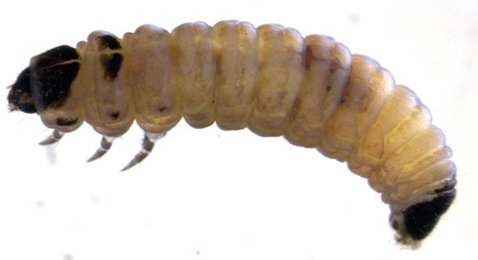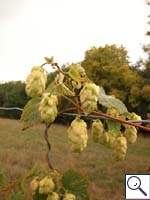|
||||||
|
HUMULUS. Hop. [Cannabiaceae] |
|
|
Two species of Humulus are recorded in Britain. These include the native Hop (H. lupulus) and the introduced Japanese Hop (H. japonica). Eight British miners are recorded on Humulus. A key to the European miners recorded on Humulus is provided in Bladmineerders van Europa. |
|
Key for the identification of the known mines of British |
Note: Diptera larvae may live in a corridor mine, a corridor-blotch mine, or a blotch mine, but never in a case, a rolled or folded leaf, a tentiform mine or sandwiched between two more or less circular leaf sections in later instars. Pupation never in a cocoon. All mining Diptera larvae are leg-less maggots without a head capsule (see examples). They never have thoracic or abdominal legs. They do not have chewing mouthparts, although they do have a characteristic cephalo-pharyngeal skeleton (see examples), usually visible internally through the body wall. The larvae lie on their sides within the mine and use their pick-like mouthparts to feed on plant tissue. In some corridor miners frass may lie in two rows on alternate sides of the mine. In order to vacate the mine the fully grown larva cuts an exit slit, which is usually semi-circular (see Liriomyza huidobrensis video). The pupa is formed within the hardened last larval skin or puparium and as a result sheaths enclosing head appendages, wings and legs are not visible externally (see examples). See Key to non-Diptera. |
1a > Leaf-miner: A distinctive mine primarily above mid-rib, with irregular short lateral offshoots into leaf blade. Pupation external (Spencer, 1972: 51 (fig. 172), 55; Spencer, 1976: 270, 271 (fig. 486)). Branched, whitish, upper-surface corridor; main axis overlying the midrib; side branches overlying the main lateral veins. (In Campanula and Phyteuma the mine is much less branched, sometimes nothing more than a corridor on top of the midrib). Frass in rather long strings. Usually the mines begins as a long and narrow, shallow, tortuous lower-surface corridor that ends upon the midrib but otherwise is not associated with the leaf venation. Often this initial corridor is filled with callus, and then even less conspicuous. Pupation outside the mine. A linear mine on the upper surface, usually following the midrib and showing side branches along the veins. The frass is in strings. |
|
Liriomyza strigata (Meigen, 1830) [Diptera: Agromyzidae]. |
1b > Leaf miner: Larva forming a long, irregular linear mine, conspicuously widening at end but not developing into a blotch; frass in diffused central green band; older mines appear whitish with little evidence of frass (Spencer, 1972b: 36, fig. 104). Upper-surface corridor, widening to the end, but never becoming a primary blotch, and only rarely a secondary one. Sides irregularly eaten out. No association with the leaf venation. Frass in a diffuse, central, green band. After a shower or two most of the frass is washed out and the mines appear white. Pupation outside the mine. A long upper surface gallery widening towards the end. Greenish, diffused frass.. |
|
Agromyza flaviceps Fallén, 1823 [Diptera: Agromyzidae]. |
1c > Leaf miner: A linear leaf-mine, widening irregularly; frass in two conspicuous black strips. |
|
Agromyza igniceps Hendel, 1920 [Diptera: Agromyzidae]. |
1d > Leaf miner: Larva forming an irregular elongate linear blotch mine, normally adjoining margin of leaf (Spencer, 1976: 137). Forms a long blotch mine, which is usually adjacent to the edge of the leaf, which turns black. Full depth corridor, mostly beginning at the leaf margin, and never starting with a closely set, intestine-like, number of curves. Further on the corridor considerably widens, mostly keeping close to the leaf margin. Often several larvae in a mine. Frass in lumps or short rods, never in long threads. Pupation outside the mine. |
| On Urtica in Britain and Humulus and possibly Parietaria eslewhere. Widespread and common in Britain. Also recorded in the Republic of Ireland. Widespread in continental Europe. |
Agromyza pseudoreptans Nowakowski, 1964 [Diptera: Agromyzidae]. |
| 1e > Leaf-miner: Mine
generally follows the leaf margin, widening from the initial linear
section into an irregular broad blotch; it is dark green when fresh
but quickly turns blackish (Spencer, 1972b: 34 (fig. 90); Spencer,
1976: 138-9, fig. 246).
Full depth corridor that mostly starts near the leaf margin, and never begins with a series in close, intestine-like curves. Further on the corridor strongly widens, and usually remains close to the leaf margin. Often several larvae in a mine. Frass in lumps or short rods, never in long threads. Puparium reddish brown |
|
| Agromyza reptans Fallén, 1823 [Diptera: Agromyzidae]. |
|
Key for the identification of the known mines of British |
Note: The larvae of mining Coleoptera, Hymenoptera and Lepidoptera may live in a corridor mine, a corridor-blotch mine, a blotch mine, a case, a rolled or folded leaf, a tentiform mine or sandwiched between two more or less circular leaf sections in later instars. Larva may pupate in a silk cocoon. The larva may have six legs (although they may be reduced or absent), a head capsule and chewing mouthparts with opposable mandibles (see video of a gracillarid larva feeding). Larvae of Hymenoptera and Lepidoptera usually also have abdominal legs (see examples). Frass, if present, never in two rows. Unless feeding externally from within a case the larva usually vacates the mine by chewing an exit hole. Pupa with visible head appendages, wings and legs which lie in sheaths (see examples). |
1a > Leaf-miner and case-bearer: The larva lives outside the mine, protected by a case, and feeds on the underlying plant tissues via a hole cut in the epidermis. From that point it eats away as much leaf tissue as it can reach without fully entering the mine. Mine does not contain frass (Coleophora species) |
1b > Leaf-miner, but not a case-bearer: The larva lives mainly inside the mine. Mine usually contains frass. In later instars the larva may live sandwiched between two more or less circular sections cut from the leaf. |
2 > Leaf-miner and case-bearer: The larva feeds on a wide range of trees, shrubs and herbs, favouring Rosaceae, but not exclusively. The fully developed cased larva may be found active in October and again, after winter diapause, in April. Cases, about 6 mm, of diapausing larvae may be found through winter, fixed to a tree or fence post. The dorsal surface of the case is usually covered in leaf fragments, but they can sometimes be worn off almost smooth. The ventral surface is swollen at the middle and has a keel, which usually bends upwards at the posterior. The cases of C. ahenella (on Rhamnus, Frangula, Viburnum and Cornus) and C. potentillae (case less swollen, keel not bent up, resting position less prone) are very similar. Brownish lobe case that lies almost flat on the leaf, either on the upper or on the lower side. Case widest about the middle. Ventrally there is a distinct keel. Mouth angle 0°. Full depth mines rather large. The flaps of cuticular tissue that serve to enlarge the case are cut out of the upper epidermis. (contrary to C. ahenella and C. potentillae, that use tissue from the lower epidermis). The removal of these tissue flaps creates holes that are much larger than those that serve as the entrance to the mine. |
 Coleophora violacea larva, lateral Image: © Willem Ellis (Bladmineerders van Europa) |
|
Coleophora violacea (Ström, 1783) [Lepidoptera: Coleophoridae]. |
3a > Leaf-miner: In the first instar the larva mines the leaves, forming short, irregular, blotch-like mines, but in later instars it lives externally, feeding in spun leaves and often twisting those of tender shoots. Larval head light-brown or yellowish brown, edged with black postero-laterally, ocellar area blackish; prothoracic plate black edged with whitish anteriorly; abdomen dull dark green; pinacula distinct, black, sometimes brownish but with black bases to setae; anal plate large, black (Bradley et al., 1973). Small, full depth mine without a definite shape; little frass. Some silk is deposited in the mine. The larva soon leaves the mine and continues feeding among spun leaves. |
|
Cnephasia incertana (Treitschke, 1835) [Lepidoptera: Tortricidae]. |
3b > Leaf-miner: The larva makes a gallery by a vein or along the midrib and feeding branches can be seen emanating from this. Broad full depth corridor overlying the main veins, with broad lobe-like, transparent, extensions into the blade. The corridor itself is quite opaque, white, later brown. The corridors, but not the extensions, are covered with silk at their inside. Almost all frass is ejected from the mine; grains may be seen trapped in silk below the mine. The larva rests lengthwise upon a vein and is very inconspicuous then. Pupation in detritus on the ground. The larva hibernates in its cocoon before it pupates. |
|
Cosmopterix zieglerella (Hübner, 1810) [Lepidoptera: Cosmopterigidae]. |
3c > Leaf-miner: A long, whitish smoothly-curved upper-surface mine with broken black frass. Oviposition is by means of an ovipositor; what remains is a small scar: no egg shell is visible at the start of the mine. From here a long, sometimes very long, slender, full depth corridor winds throught the leaf, not steered by leaf margin or the leaf venation. The midrib is crossed effortless; the corridor frequently also crosses itself; the section of the leaf cut off then usally turns brown and dies off. Frass in a narrow central line. The larva vacates the mine prior to pupation through an exit in the upper epidermis. The vacated larval chamber is proportionally much longer than in the case of Stigmella mines ( > 3 x longer than broad). Pupation in a silken cocoon suspended from threads attached to food plant or other vegetation. |
|
Lyonetia clerkella (Linnaeus, 1758) [Lepidoptera: Lyonetiidae]. |
| Last updated 05-Jul-2019 Brian Pitkin | ||

